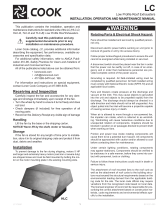
I-MAPSIII&IV-ER, PN262634R3, page 9
Removing, Cleaning, and Replacing Wheel Segments - The segments are the “heat
exchangers” of the energy recovery wheel. Segments must be handled with care and
should never be dropped. Segments may require “slight” persuasion during installation
and removal but NEVER be forced or banged with a hammer or similar tool.
Instructions:
1. Turn off power to the unit and lock the disconnect
switch open.
2. Slide the wheel cassette out of the cabinet (refer to
illustration, page 7).
Remove the wheel segments (from the pulley side of
the wheel)
a) Rotate the wheel to position the rst segment to be
removed at the top. On both sides of the segment,
unlock and open the two retaining straps.
b) Using hand pressure only and supporting the
segment, from the motor side push the wheel
segment. On the pulley side, lift the segment out of
the spokes. Lay, do not drop, the segment on a at
surface
c) Rotate the wheel so that the segment on the
opposite side is on the top. Repeat the procedure
and remove the segment. Continue the procedure
of keeping the balanced open and lled segments
opposite each other and remove all of the
segments.
3. Clean the Wheel Segments
a) Gently brush off any loose dirt and dust.
b) To wash the segments, use a non-acid based
(evaporator) coil cleaner or alkaline detergent
solution. Non-acid based coil cleaner concentrate
in a 5% solution is recommended by the
manufacturer. Do not use any of the following as
they may cause damage to the wheel.
DO NOT use an acid based cleaner.
DO NOT use aromatic solvents.
DO NOT use temperatures in excess of 170°F.
DO NOT use a pressure washer.
DO NOT use steam.
Soak the segments in the cleaning solution
until grease and tar deposits are loosened. An
overnight soak may be required to adequately
loosen heavy deposits of oil based contaminants.
CAUTION
DO NOT use acid based cleaner, aromatic
solvent, steam, temperatures in excess of
170°F, or a pressure washer, as damage to
the wheel may occur.
Rinse the dirty solution from each segment until the water
runs clear. NOTE: Some staining of the desiccant may
remain and is not harmful to performance. Allow excess
water to drain from the segments before reinstalling
them in the wheel. (NOTE: A small amount of water will
dry out in the airow.)
4. Replace or Re-install Clean Wheel Segments (from
pulley side of wheel)
a) Remove any dirt or dust from the wheel frame and
cassette and the slide-in area of the cabinet.
WARNING
Weight of the installed segments will
cause the wheel to accelerate in rotation.
Failure to maintain control of the wheel
rotation while re-installing all segments
could cause severe injury to ngers or
hand caught between revolving spokes
and the bearing support beam. Insert
the handle of a hammer or other such
tool through the spokes above or below
the bearing support as a stop to limit
rotation of an unbalanced wheel.
b) Position one segment opening at the top of the
cassette. Insert a “stop” (see warning above) to hold
the wheel in place. Unlock and open the segment
retaining brackets on both sides of the opening.
Position a clean segment with the imbedded
stiffeners toward the motor side of the wheel.
Holding the segment as vertically as possible and
centered between the spokes, insert the nose of
the segment downward between the hub plates.
Ease the segment down until its outer rim clears the
inside of the wheel rim and press it inward against
the spoke anges. Close and latch the retaining
brackets. Make sure each retaining bracket is fully
engaged under the catch.
c) Remove the stop and slowly rotate the installed
segment to the bottom of the wheel. Re-insert the
stop and repeat the procedure to put a segment in
the top position. Continue the procedure, balancing
the wheel by installing opposite segments, until all
of the segments are in place.
d) While the wheel cassette is out, follow the instructions
below to check the seals and the drive components.
e) After all wheel maintenance is complete, slide the
casette back into the cabinet. Re-connect the motor
wire. Being sure the cassette is positioned properly,
replace the center post.
According to the manufacturer, a wheel operating in a “clean” environment may not
require annual cleaning, but a wheel in a “contaminated” environment may require mul-
tiple cleanings a year to maintain airow and recovery. The segmented design of the
wheel not only provides for easier cleaning but also allows for replacement of individual
dirty segments. (See replacement P/N’s on page 10.).













